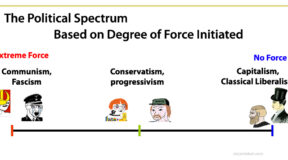
In the “What market failure” we will look at the various claims that the free market failed, and show that the principles of the free market did not fail, but where coercively distorted by government intervention.
Claim: In accounting practices we saw how government regulation lead to the destruction of banks lending capacities that would never have arisen under a free market. So government regulation was responsible for much of bank’s capital losses through faulty accounting practices. But why couldn’t the banks recapitalize them selves by issues debt(borrowing) or selling for stock on the free market. They couldn’t do this, so this means the free market failed, thus the 750 billion TARP program(government loans) had to be passed.
Did you ever wonder by at the end of September 2008, Henry Paulson all of the sudden announced that he needs around 1 trillion dollars or the banking system will fail because banks can not get capital? The financial crisis at this point had been going on for a while, a few large banks had already went under, some where bailed out some where sold. So what all of a sudden caused this massive emergency that a 750 billion bailout had to be passed and signed by Bush on Oct 3d 2008, just around 2 weeks after Paulson’s announcement. Was the emergency a result of the failure of the free market or did the government cause it?
What happened is that at around September 25th 2008 the FDIC took over Washington Mutual bank and sold it to JPM for 1.9 billion dollars. The problem is that in this deal orchestrated by the fed, both uninsured and insured depositors where acquired by JPM for their payment of 1.9 billion and did not absorb any loses, but the debt holders where not acquired by JPM. This effectively wiped out all the debt holders and stock holders of Washington Mutual. They will not receive anything back on their original investments. Debt holders are individual people, financial institutions, other corporations, or any other entities that lend money through bonds or other instruments. They are where banks, corporations, ect, acquire capital from on the free market. In normal bankruptcy proceedings debt holders are first in line to get something paid back to them. When the debt holders of Washington Mutual where wiped out, the market for acquiring capital was frozen. After all, who is going to lend out any money, if at anytime the government can seize the assets and wipe them out.





1 Comment
Dr. Doom
(December 2, 2024 - 12:23 am)These arguments are flawed for several reasons:
1. Misrepresentation of Bank Failures: Washington Mutual’s failure and subsequent sale were not unusual during the crisis. Debt holders lost money because the bank was insolvent, not because of arbitrary government action. In bankruptcy, debt holders are repaid only if assets exceed liabilities, which wasn’t the case here.
2. Market Capitalization Freezing: The claim that government actions froze the capital market ignores the broader crisis of trust. Private lenders hesitated to provide capital because of widespread uncertainty about asset valuations, not solely because of Washington Mutual.
3. Role of TARP: The Troubled Asset Relief Program (TARP) wasn’t solely about replacing private capital; it aimed to stabilize the system by addressing liquidity issues and restoring confidence. Without TARP, the banking system faced systemic collapse, which wasn’t purely a product of regulation.
4. Oversimplification of Government Role: The narrative overlooks critical factors like unregulated derivatives markets and excessive private-sector risk-taking, which were central to the crisis. While government missteps contributed, blaming regulation alone ignores systemic market failures.